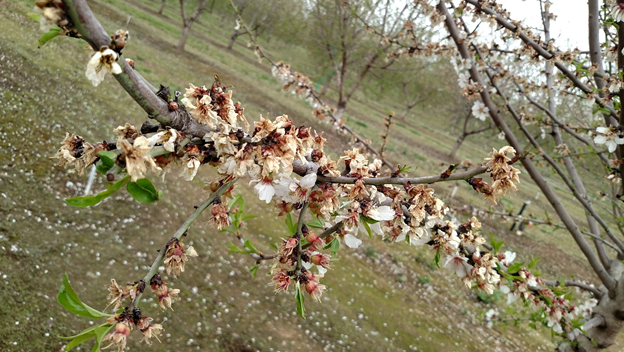Bacterial blast, although thankfully not a problem every year (hopefully including 2020), can be tremendously damaging to almond yields. Although bacterial blast was more prevalent in the San Joaquin Valley in 2019, in both 2017 and 2018 some almond growers in the Sacramento Valley had 20-40% crop losses, in part due to blast. For example, bacterial blast hit some varieties in the Regional Almond Variety Trial at the California State University, Chico (CSUC) Farm particularly hard in 2017. The bacteria Pseudomonas syringae which can cause both blast and canker is ubiquitous on surfaces in our orchards, however it only causes infections under the right conditions. The right conditions for bacterial blast and canker are wet and cold (e.g. frost). For example, in 2017, the Regional Almond Variety Trial at CSUC experienced four nights below 30ᵒF coinciding with full bloom (photo 1). Copper has been the only main control measure for this disease, however resistance is widespread and results have been highly inconsistent. Because Sacramento Valley almond growers were significantly impacted by bacterial blast in two of the last three years, crop loss data from Sacramento Valley counties supported a Section 18 emergency request for the use of Kasugamycin on almonds.
The EPA approved this emergency request for Kasugamycin (Kasumin 2L) use during the 2020 bloom season. The request was granted for select counties that had supplied crop loss data, these counties included Yolo, Sutter, Yuba, Colusa, Butte, Glenn, and Tehama. This registration allows for use of Kasugamycin for bacterial blast when cold or freezing conditions are expected. This limited registration is only valid from February 14 to April 15 (no applications allowed after petal fall). There is a limit of two applications by ground, with 7 days between applications, and no alternate row spraying. Read and follow ALL label guidlines. If you are interested in using Kasugamycin during bloom, please contact your local Agricultural Commissioner’s office.
Mention of a pesticide does not constitute a pesticide recommendation. Always follow the pesticide label. Special thanks to Dr. Jim Adaskaveg who wrote the Section 18 request, to Elaine Trevino and the Almond Alliance who submitted the request to DPR, and to the Sacramento Valley almond growers who supplied crop loss data.



Leave a Reply